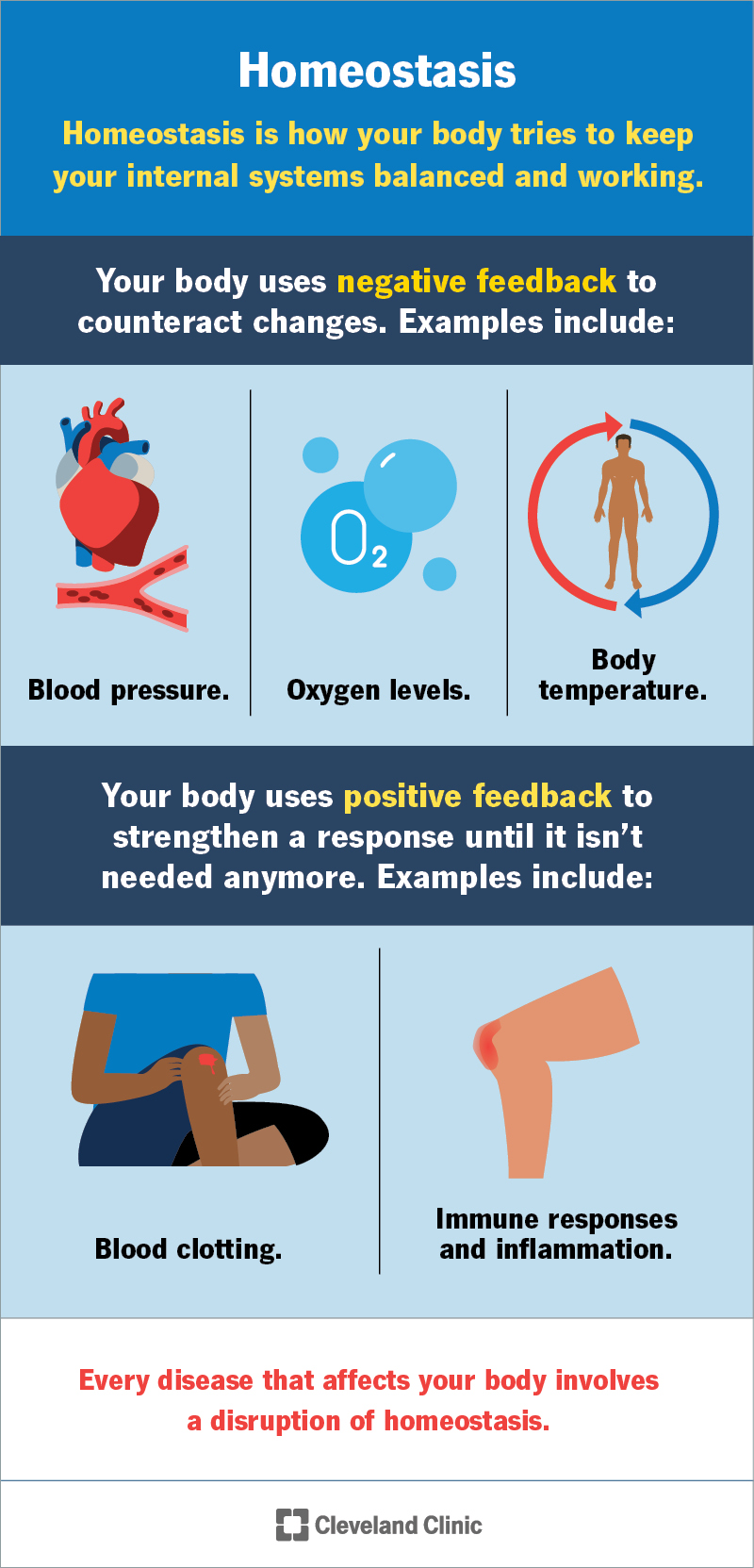Homeostasis is how your body systems regulate and maintain themselves. When they do, it’s easier for your body to function at its best. Homeostasis also helps your body adjust conditions to keep things balanced, and to try to help you recover from injuries and illnesses.
Advertisement
Cleveland Clinic is a non-profit academic medical center. Advertising on our site helps support our mission. We do not endorse non-Cleveland Clinic products or services. Policy

Homeostasis is how your body regulates your internal systems so they function correctly. Your body works best when its internal environment — including things like temperature or oxygen levels — is just right.
Advertisement
Cleveland Clinic is a non-profit academic medical center. Advertising on our site helps support our mission. We do not endorse non-Cleveland Clinic products or services. Policy
The term homeostasis comes from two ancient Greek words meaning “equal” and “holding still.” In other words, homeostasis means reaching and maintaining a state of balance. In this context, balance isn’t about keeping you from toppling over. It’s about having the right balance of everything you need.
Balance is key because too much of even the most essential things can be harmful. For example, everyone knows that water and oxygen are good things, and you need them to survive. But drinking too much water too quickly can cause hyponatremia. And breathing pure oxygen for too long can cause oxygen toxicity. Both of those conditions can be deadly.
Homeostatic processes are automatic, and a specific part of your brain, the hypothalamus, runs them. There are two main ways that homeostasis happens:
Negative in this context doesn’t mean bad. It means your body senses a change and tries to counteract or reverse the unwanted change. Most homeostatic processes in your body rely on negative feedback.
Examples of negative feedback homeostasis include:
Advertisement
Positive feedback homeostasis means the processes add to themselves and get stronger. That will keep on happening until the initial cause is gone.
Examples of positive feedback homeostasis include:
You can’t survive without homeostasis and the processes that drive it. And every disease or medical condition involves a disruption of homeostasis.
When you get hurt or sick, your body adjusts its homeostatic processes so you can recover. That’s why you get a fever with infections or your blood clots when you have a bleeding wound.
Chronic conditions happen when something goes wrong and your homeostatic processes can’t adjust enough to make up for it. For example, high blood pressure (hypertension) happens when your body can’t keep the pressure within a healthy range. Osteoporosis happens when your bones lose calcium faster than your body can replace it.
Some diseases happen because homeostatic processes malfunction and make things worse. Examples include:
Advertisement
Your nervous system balances its own activity using two subsystems that do opposite jobs. Those subsystems, which are part of your autonomic nervous system, are your:
Your skeletal system constantly goes through a maintenance cycle of breaking down and replacing old bone tissue. You need vitamin D and calcium for that to work properly. But that maintenance process slows down naturally as you age. And if you lose bone tissue faster than your body can replace it, you can develop conditions like osteopenia or osteoporosis.
Your respiratory system helps maintain multiple types of homeostasis. Two key examples include:
Advertisement
Your endocrine system supports homeostasis for multiple systems. That’s partly because your endocrine system creates many key hormones, which are like chemical messengers. They can tell your body systems when to start or stop certain processes. Examples include your digestive system, metabolism, and the male and female reproductive systems.
Your muscular system relies on and supports homeostasis in multiple ways. One example is how your muscles constantly break down and rebuild themselves. Your muscles are also important for temperature homeostasis, especially when they generate heat to keep you warm.
Just like Goldilocks inside the home of the Three Bears, your body works best when everything is just right. Understanding how homeostasis works means you can make it easier for your body to find and hold the right balance for its systems. Maybe that means drinking more water, going for a walk or taking medication to manage a condition. Finding and maintaining balance may take work, but it can also make a big difference in your quality of life.
Advertisement
Cleveland Clinic’s primary care providers offer lifelong medical care. From sinus infections and high blood pressure to preventive screening, we’re here for you.

Last reviewed on 02/07/2025.
Learn more about the Health Library and our editorial process.